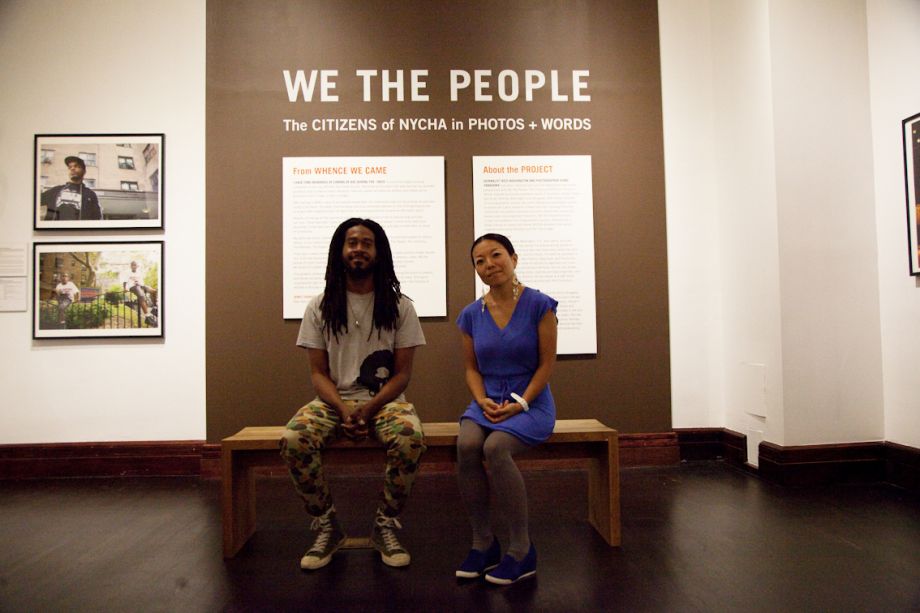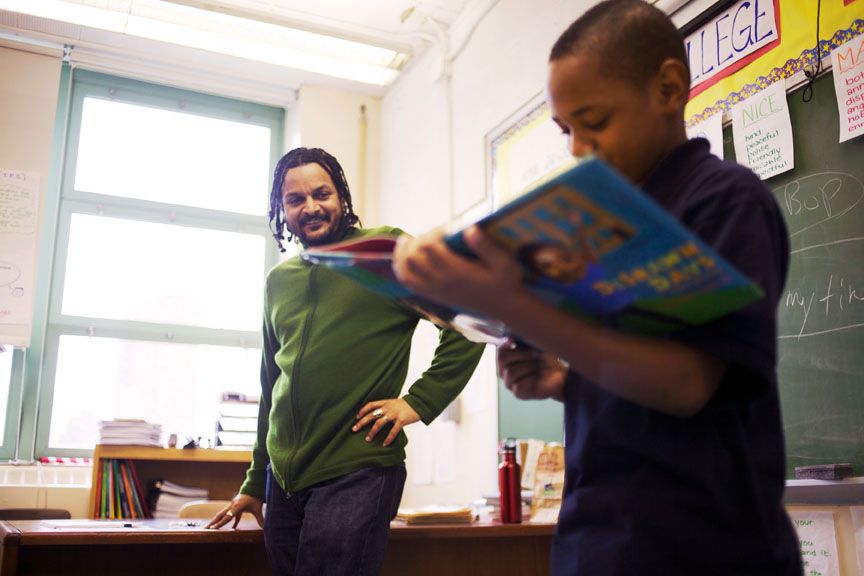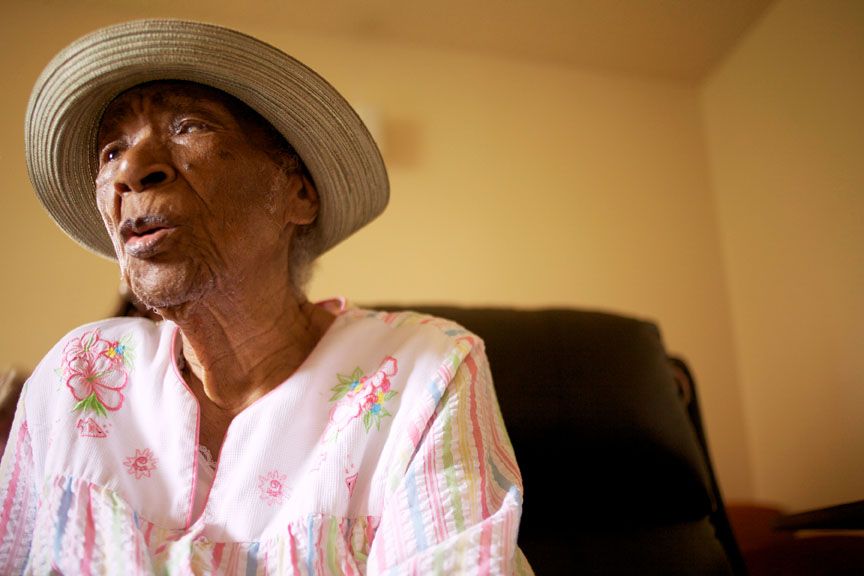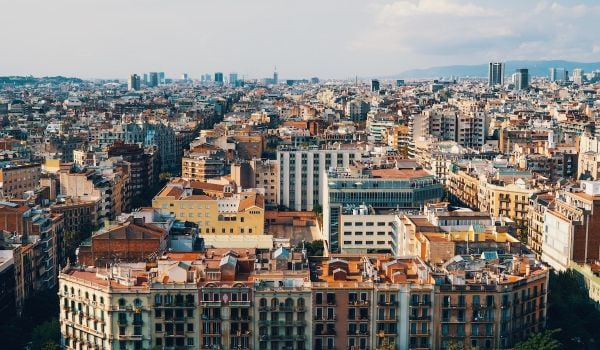As the New York City Housing Authority considers how to improve and maintain public housing into the next half-century, two artists are tackling how to change public perception about the people who transform these places of shelter into homes.
In 2009, writer Rico Washington and photographer Shino Yanagawa, who are both based in New York, embarked on a documentation project that sought to address inaccurate representations of public housing residents in the media. Both had experience living in housing projects. (Washington grew up in Kimberly Gardens in Laurel, Maryland, and Yanagawa briefly lived in NYC public housing.) Both were aware that these communities are much more diverse, dynamic and determined than what’s conveyed by the stories about crime and poverty on the nightly news.
They interviewed 50 former and current NYCHA residents and the culmination of their years of work is the exhibit “We the People: The Citizens of NYCHA in Photos and Words,” which is currently at the Brooklyn Historical Society through March 8th.
I asked Washington about the exhibit, an outgrowth of the work called Debunk the Myth, and how he and Yanagawa are inspiring a new generation of storytellers.
How have current and former public housing residents been reacting to the exhibit?
The response has been overwhelmingly positive. We’ve had people tell us their own stories about being from public housing, even though they had previously not wanted to tell anyone. They’ve omitted that part of their own personal stories. [They saw] this project and understood that they were not such an anomaly.

Rico Washington (left) and photographer Shino Yanagawa (Photo by Shino Yanagawa)
There’s the phenomenon of lack of representation and then misrepresentation. While you were doing this project, what was your awareness of correcting misrepresentation?
We definitely kept that in mind when we were doing the project. That’s the crux of the hashtag we’ve been rolling with, #Debunkthemyth. That’s what we set out to do.
We understood — being that I came out of public housing and Shino lived for a time in public housing — that there were widely held myths about public housing, specifically blacks and Latinos that live in public housing. The range of pejorative myths and stereotypes go from the idea that everyone is raised in a single-parent household, to everyone being involved in illicit activity in one way or another, to people being overly dependent or abusive of public assistance. The list goes on and on.
What stories helped to ‘debunk the myth’?
There’s the story of the centenarian [Susie Mushatt-Jones, pictured above] who has been able to put several of her nieces through college. [Paying for] tuition, full room and board, books, everything. She was able to do this from working as a domestic for the majority of her life.
You have the story of Brian Paupaw who received a scholarship to attend Parsons. He went snowboarding at the suggestion of a college roommate, and fell in love with it. Subsequently after college, he put the foundation together for a nonprofit that takes kids from neighborhoods like he grew up in and takes them out snowboarding, skiing and biking outdoors — things that don’t fit with the “norm” when you talk about blacks and Latinos.

Professor, author and poet Tony Medina talked about life in public housing for the exhibit “We the People: The Citizens of NYCHA in Photos and Words.” (Photo by Shino Yanagawa)
Did you find generational differences?
Absolutely. When you talk about the older people that we interviewed, specifically [photographer] Jamel Shabazz, the stigmas around public housing weren’t as pervasive when he was growing up. When people were moving in during the ‘50s there was still hope of upward mobility, which was the premise of public housing. He talked about people being neighborly and contributing to the greater good of the community.
What are your next steps?
We’re looking at [Debunk the Myth] becoming a workshop series instructing NYCHA residents to basically do what we did. We’re going to be talking about the curatorial process. We’re talking about artistic literacy. We’re talking about journalism, photography and interview skills.
Storycorps is going to be helping us out. We’re also going to be exploring citizen journalism and media literacy. Like being able to get to the main point of a story and understand what’s being said even though it’s not being verbalized. This is going to culminate in a group exhibit.
It will equip people with these skill sets that Shino and I have acquired over the past five years, whether they want to pursue these as a career or just continue to tell first-person stories about what’s going on in their communities.
How much do you want to grow this project?
We want to make this a national conversation, being that public housing stock around the country is diminishing, make no mistake about that.
We have to ask ourselves, ‘Why is it diminishing?’ There’s also the conversation about the stigma about public housing that’s been propagated around the media and how that impacts public opinion and how that impacts the work of government agencies.
I think that’s a cycle that not many people are aware of.
Absolutely. That’s one of the goals. It didn’t start out being one of the goals in 2009. But as we started to talk to people — and not just residents, but the people coming out to the exhibits — we saw how the response has been overwhelmingly positive.
In general, people like to see representations of themselves in public spaces, whether in the media, nominations for the Oscars, on television. What truer representation of yourself can there be than a photograph or video of you, and someone profiles your story? In that respect, people have been really happy with what we’ve done.

Actor Ephraim Benton talked about life in public housing for the exhibit “We the People: The Citizens of NYCHA in Photos and Words.” (Photo by Shino Yanagawa)
The Equity Factor is made possible with the support of the Surdna Foundation.

Alexis Stephens was Next City’s 2014-2015 equitable cities fellow. She’s written about housing, pop culture, global music subcultures, and more for publications like Shelterforce, Rolling Stone, SPIN, and MTV Iggy. She has a B.A. in urban studies from Barnard College and an M.S. in historic preservation from the University of Pennsylvania.

















